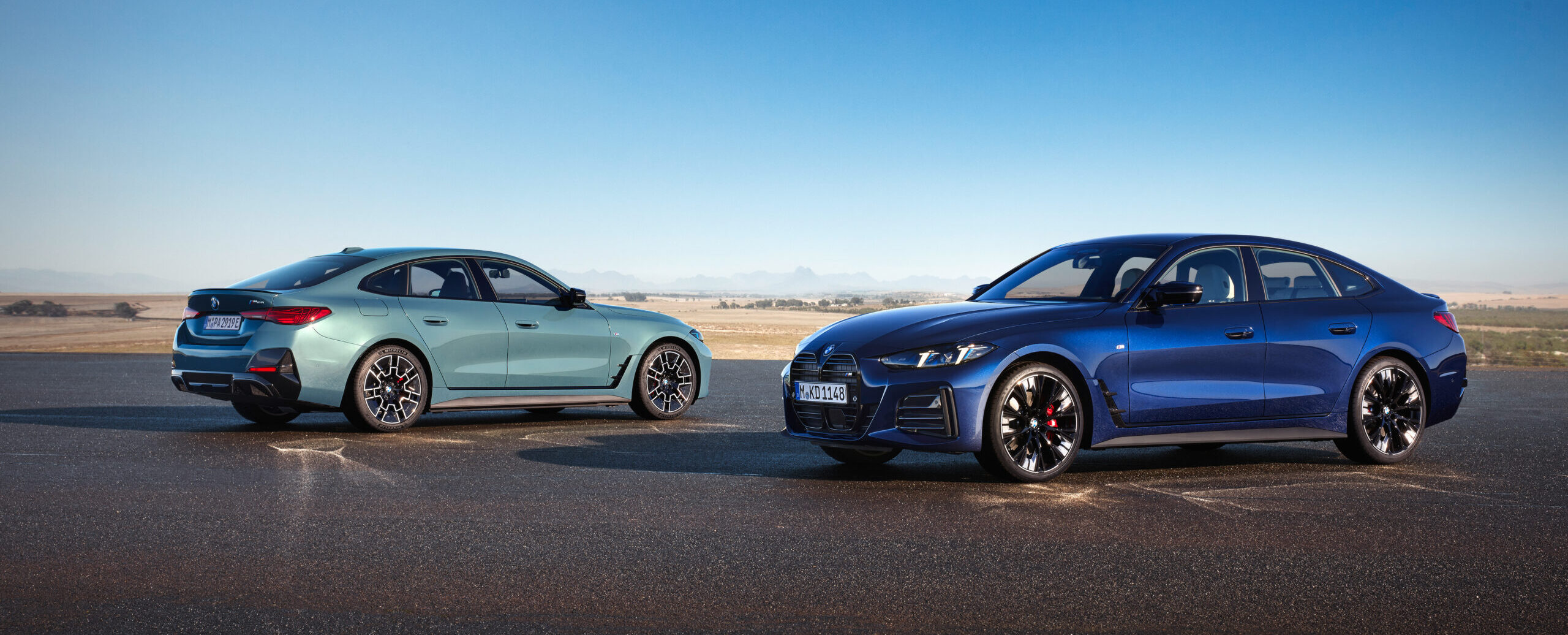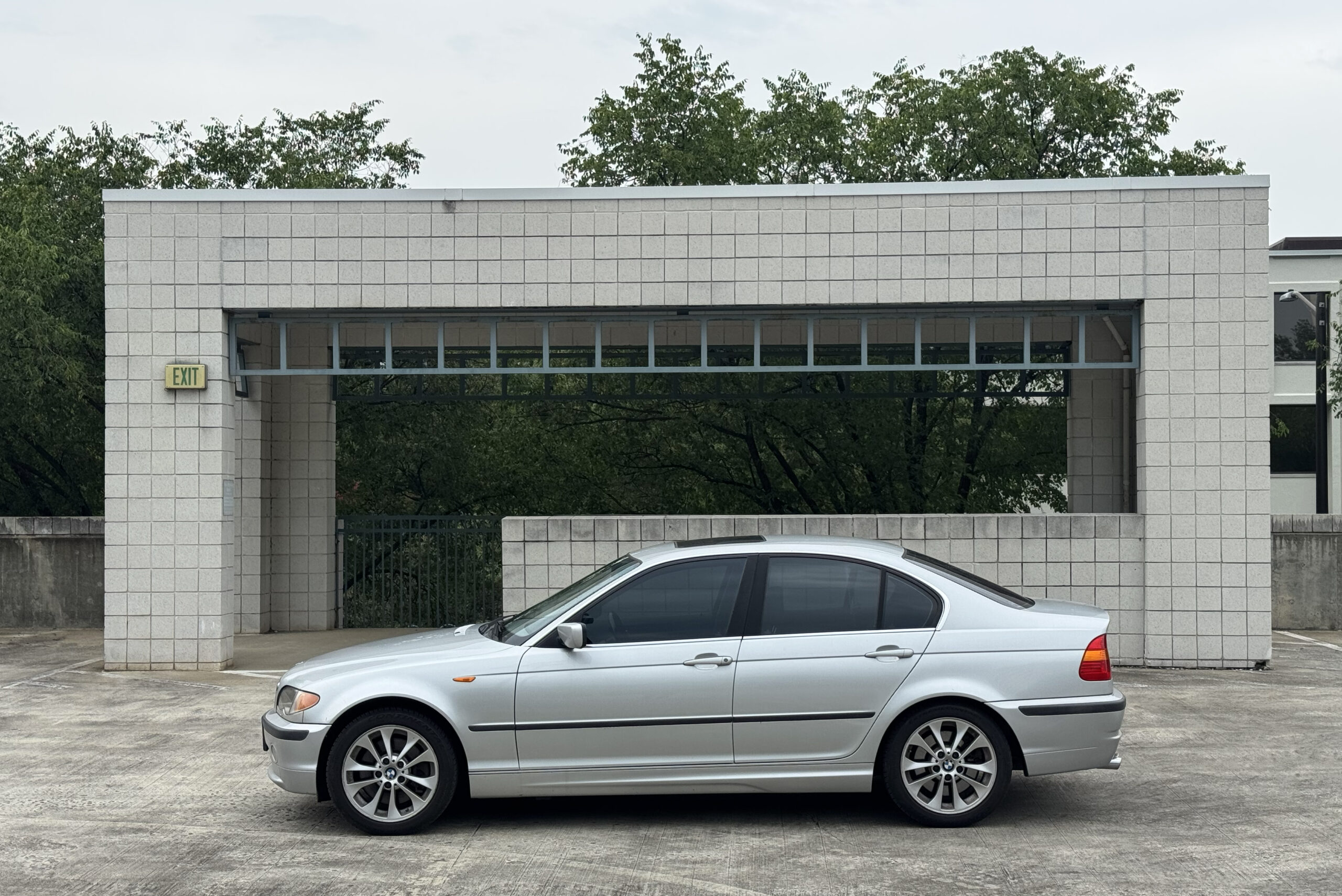I ended last weeks’ piece with the cliffhanger that everything was going swimmingly prepping Bertha for the 2000-mile round trip to the Vintage in Asheville, right up until I found the cracked front subframe—I wasn’t kidding.
The front subframe on 2002s have an ear that stands vertically to support the left-hand engine mount. With age and pounding, it’s very common for this ear to crack part-way up. This happened on Kugel, my Chamonix ’72 tii, a few years ago. I heard a lot of metallic rumbling, and found that the engine was clearly cocked to the left. When I crawled under and examined the ear on the subframe, I found that it had cracked, and the upper half had slid down over the lower half. To fix it in Kugel, I held the engine up using a ratchet strap and a 2×4, dropped the front subframe out of the car, and took it to my friend Tom Samuelson who welded the crack and braced it with additional metal. I then reinstalled the subframe, and the entire endeavor was quite a bit of work.
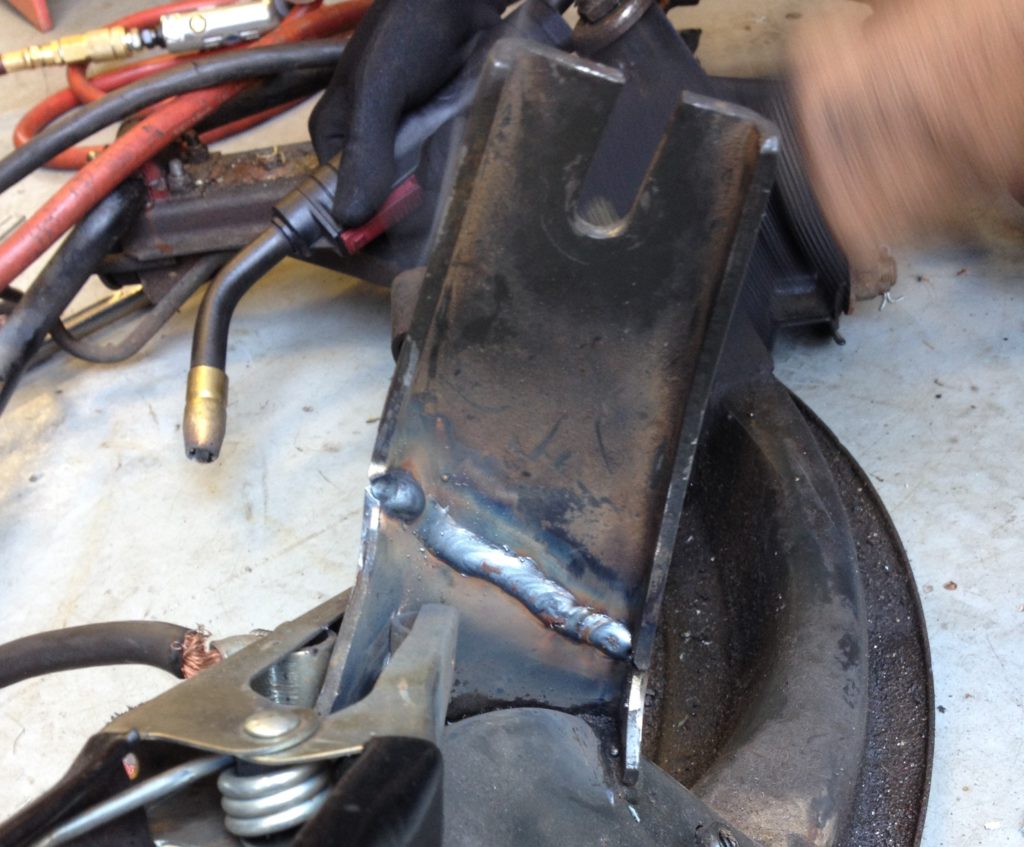
The engine mounting ear on Kugel’s front subframe, shown during the welding repair.
What I found on Bertha wasn’t a fully-separated crack like Kugel had, but instead an un-separated fracture. And, reassuringly, there was no fresh, clean metal showing. It was likely that the crack had formed decades ago.

The crack in Bertha’s front subframe had fortunately not separated.
I could’ve done several things. I could’ve dropped the subframe and tried to weld it myself, since I now own a welder. I could’ve taken it to Tom. I could’ve inspected the faux tii parts car in my driveway and, if its subframe was un-cracked, swapped it in.
Instead, I did none of these things. Since the crack looked like it hadn’t grown in quite some time, I simply packed a piece of 2×4 and a ratchet strap so that, if the crack broke open, I could, if necessary, lift up the left side of the engine and try to limp the car on down the road that way. Hey, if you’re going to be in denial, you might as well go all-in.
There were a few other last-moment sort-out issues. I’d fully rebuilt Bertha’s air conditioning system last summer, including new hoses and fittings, along with a new parallel flow condenser. I expected to simply turn it on and enjoy cold air in the cabin. Silly me—I hooked up the gauges and discovered that the refrigerant had clearly leaked out over winter.
First, I used the UV light and yellow glasses to illuminate the dye in the refrigerant oil and see if I could locate the leak that way, but there was no glowing gun, just small traces left over from the installation.
Next, I pumped the system full of nitrogen, and found it leaking from the fitting on the input hose to the drier, which, incredibly, wasn’t even hand-tight. How it ever held last summer, who knows. I tightened it, but when I pressure-tested the system again, it still leaked. I chased the leaks and found that they were coming from two of my crimp-on hose fittings. I re-crimped them, tested it a third time, and this time it held. After evacuation and recharge (R134a on this car), it was back to blowing cold; the vent temperature probe read 32 degrees. Granted, it wasn’t very hot in my garage when I recharged it, but this was reassuring. At a minimum, it restored a shred of credibility and dignity to a guy who wrote an air conditioning book yet apparently botched some aspects of his own installation last summer.

That’s what you want to see.
The final task was fixing the sunroof seal, which was so deteriorated that airflow at freeway speeds had ripped it out of its groove and caused it to mercilessly flog the roof. I’m not a big fan of sunroofs; I’ve always felt that, if you want the sun on your face, sunroofs are a poor substitute for a convertible. I hadn’t even opened Bertha’s sunroof once since resurrecting the car. I was about to simply caulk the sunroof shut with clear silicone, but then remembered that both pieces of a sunroof seal might have been among the parts that were given to me by the widow of a Boston CCA chapter member. I couldn’t believe my good fortune when I found both pieces, undamaged. I carefully cranked the sunroof open. It was slightly cocked, but still functional. An hour or so later, I had both pieces installed, and once the glue was dry, I carefully cranked it closed. I may well leave it closed, but even still, the seal is way better than caulk.

The sunroof seal partway through installation. Robby the Robot on the Forbidden Planet poster can now drop Anne Frances in through the sunroof.
With prep complete, I packed Bertha with the usual assortment of tools and parts, and prepared to leave on Wednesday morning. One thing I didn’t pack was my aluminum floor jack and aluminum jack stands because they were still in the trunk of Louie, my other tii. You know, the one that had been at the Icon exhibit at the BMW CCA Foundation, having never made it home due to bad weather. It’s still at Lance White’s place in Cincinnati. I thought about buying another aluminum floor jack and stands, but instead I threw a very small floor jack, suitable for little more than changing a tire, in the trunk, figuring that if I really needed jack stands to fix something while on the road, one of my companions could run and buy them.
The plan was to travel with most of last year’s crew; Andrew Wilson, Jose Rosario, Bob Sawtelle, and myself—with Andrew in his E28 M5 and the rest of us in our 2002s. A few days prior, three other people asked to caravan with us. Shortly before departure, Jose reported that the newly-installed engine in his 2002 appeared to have a cracked block. Obviously there were discussions to be had with the person who took ten months to install the engine, but in the meantime, Jose was resigned to taking his E46.
Ironically, after fixing Bertha’s a/c, what I really needed on Wednesday morning was heat. The previous night, a freak mini-Nor’Easter had moved into New England. We didn’t get snow, but it was about 40 degrees when I left my house. I slid Bertha’s heater lever to on, and shivered waiting for warm air to pour through the vents. It never came. When I arrived at the convoy’s meeting point, I found that the Bowden cable had broken at the heater valve, requiring me to open the hood and open or close the valve by hand.
We all met at the Charlton service plaza on I90 at seven A.M. Wednesday morning, and then the caravan suddenly shrunk in size. First, Bob Sawtelle bailed. With a pale face, he explained that he had a kidney stone that was in the process of passing, had hoped it would resolve itself before the trip, but now knew he should either drive home or to the hospital. It broke his heart not to go, but he knew that it would be insanity. Andrew and I, who had both been in this situation a few years back (I missed Vintage 2011 for the same reason), reassured him he was making the only choice to be made. I’ve since spoken with Bob, and he’s okay, but deeply disappointed—that’s his sweet Agave 2002 in the photo below.
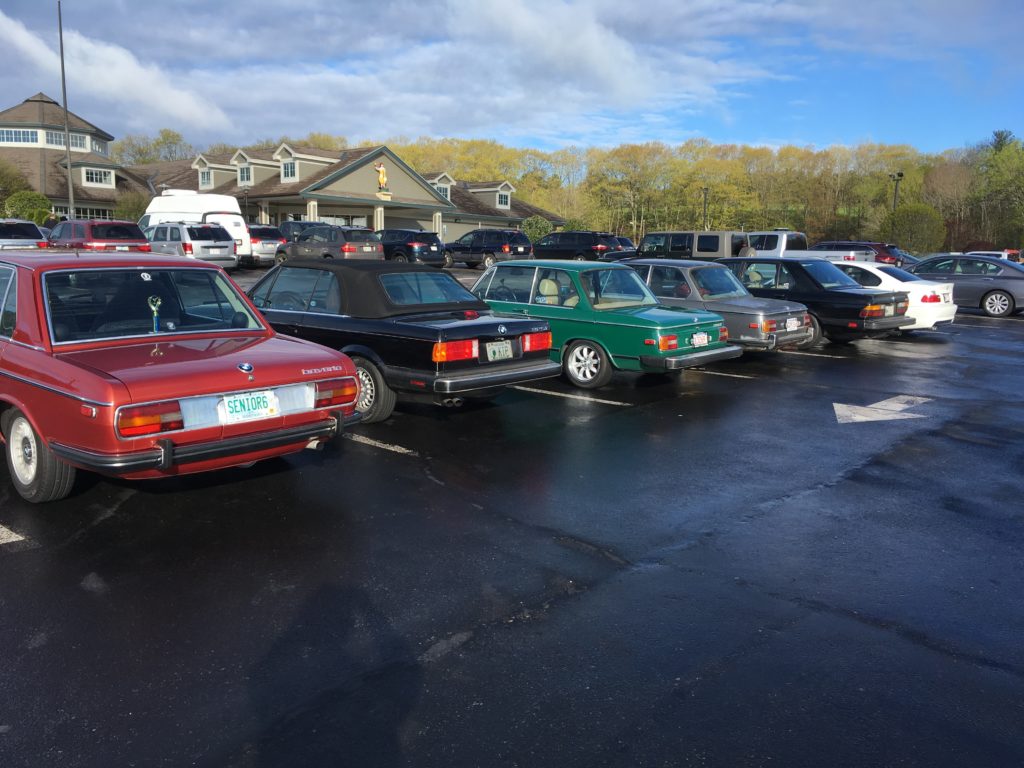
The caravan looked big—until it shrunk.
Then the other three fellows—the three last-minute additions to the caravan—decided to take a different route, heading west on I84 instead of snaking down the Merritt Parkway as we were planning to do. We agreed to meet up along the way.
At about 8am, the shrunken caravan of Andrew Wilson in his M5, Jose Rosario in his E46, and me in Bertha bringing down the property values, began the two-day trek. It’s about 900 miles from my house to the host hotel for the Vintage. I’ve done it in a day, but by the end, I felt like someone had rolled my brain and eyeballs in sand. Two days is better. The first day destination was Staunton, Virginia.
All was going well until we reached Allentown, Pennsylvania. Andrew radioed that the oil light in his M5 just came on, and we immediately pulled into the breakdown lane. “Oil pressure, or oil level light?” I asked, imagining catastrophic damage to his expensive S38 engine if it had lost oil pressure. “Oil level,” he said. Sure enough, the oil level wasn’t even reaching the dipstick. Fortunately, I’d thrown a five-quart jug of Castrol into Bertha’s trunk; the M5 drank more than half of it. That oil level warning light probably saved the S38.
After we headed off, Jose noticed that, while following the M5, his windshield was getting coated with oil dripping from the car. Right; so the M5 had been low on oil because it was actively leaking. It should’ve dawned on us to check that, but I try to keep intervention on interstate breakdown lanes to as short a time as possible.
We took the first exit and pulled into a parking lot. I donned a Tyvek suit, crawled under the car, and found oil dripping at a pretty good rate from the left side of the block, but I couldn’t localize the source. Andrew called Mario Langsten at VSR1 who maintains the M5. Mario said it was likely coming from a failed oil pressure switch located behind the alternator and above the power steering pump. From what I was seeing, this made perfect sense. But I’ve never worked on an S38 engine, and I wasn’t sure if you needed to pull the upper radiator hose to remove the alternator.
We talked about what to do next. Andrew found a BMW dealership (Daniels BMW) about eight miles away. As long as the oil level was full, the leak didn’t seem to be large enough to put the engine at risk for the short drive. Unfortunately, the dealer didn’t have the pressure switch in stock (not that we were even certain that that was the problem), and couldn’t work on the car until the next day anyway. We discussed other options, such as buying a set of jackstands and fixing it ourselves, but without the part in hand, it was a moot point. Andrew decided to leave the M5 at the dealer, ride down with Jose in the E46, and hopefully pick the car up on the way back. Once word was put out on Facebook about what had happened, E28 good guy Aaron Manderbach chimed in that he was only about 30 minutes from Allentown and had the pressure switch, but we were already hundreds of miles south by then. You make the best decisions you can based on the facts that you have at the moment.
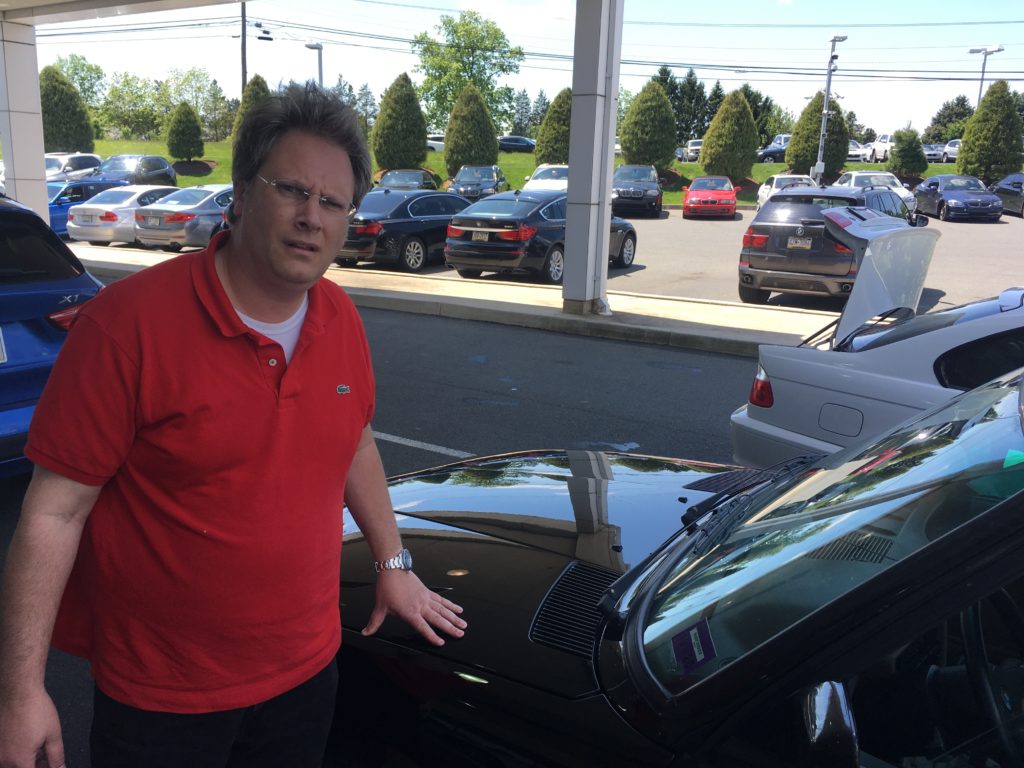
Andrew Wilson left his M5 at the dealer and gave me his best “I am so disappointed” face.
Oh. Bertha. This is supposed to a piece about Bertha. Where was Bertha in all of this?
Only being a total rock star. The dual Weber 40DCOEs and the 300 degree cam have a few flat spots and stumbles at certain RPMs, and 4th gear synchro in the 5-speed is so bad that, to downshift to 4th, you need to put it into 3rd and then 4th, but other than that, the car purred. At one point, an intermittent snotty-sounding rumble became progressively worse, sounding like a transmission bearing or center support bearing about to let go. We pulled into a rest area to check it out. I drove to the end and found a little service alcove where I could jack the car on cement instead of asphalt. The area even had a few tree trunks I could put under the frame rails (no jack stands, remember?). I crawled under just long enough to see that the source of the noise was the exhaust headpipe touching the transmission support bracket. Once I knew that it wasn’t a big deal, my brain filtered out the noise instead of imaging that my balky transmission was about to blow up.

This little alcove at a rest area on I81 seemed tailor-made for Bertha.
We reached Staunton Virginia by about 7 pm on Wednesday evening. That left only about 5 1/2 hours of driving on Thursday. We arrived at the event hotel in Asheville at about 1:30 in the afternoon. I’ve never had such an early arrival.
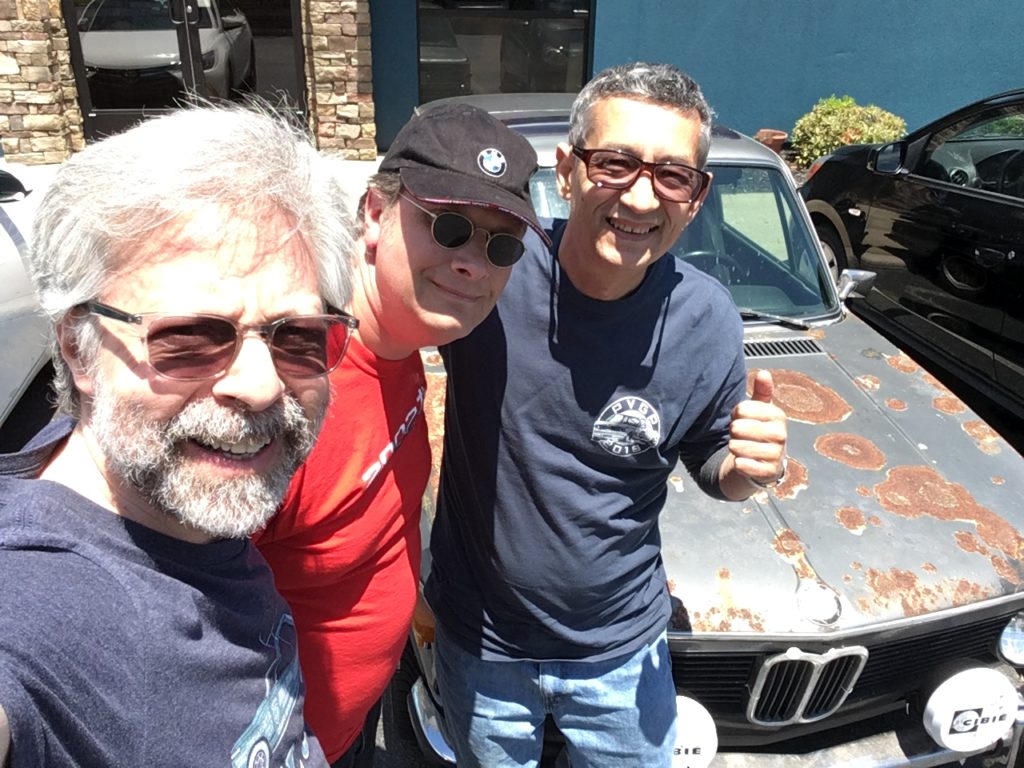
Bertha and the boys, triumphant at their arrival at the host hotel for the Vintage.
By the end of the day on Thursday, Andrew had heard from the dealer that the problem with the M5 was indeed a leaky oil pressure switch, and that the car was all fixed. We planned to pick it up when we went back through Allentown on Monday.
So, after being locked in my friend Alex’s neighbor’s garage for 26 years, and then rescued and resurrected by yours truly, Bertha was as happy as an indoor cat that’s escaped the house. The drive down was nearly flawless, but there was still the trip to the BMW CCA Foundation for the opening of the Passion exhibit, the drive to Hot Springs for the Vintage event itself, and the return drive home. So I wasn’t popping the champagne (or stowing the antifreeze) just yet.—Rob Siegel
Rob’s new book, Just Needs a Recharge: The Hack MechanicTM Guide to Vintage Air Conditioning, is available here on Amazon. His previous book Ran When Parked is available here. Or you can order personally inscribed copies of all of his books through Rob’s website: www.robsiegel.com.











